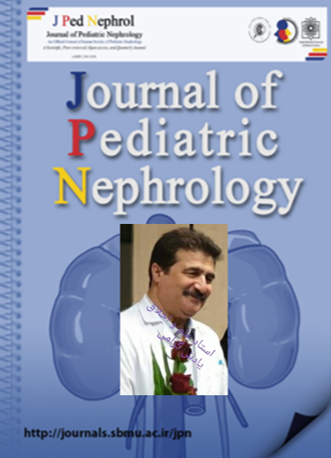A Teenager Presents With Hypokalemia and Metabolic Alkalosis Hypokalemia
Journal of Pediatric Nephrology,
Vol. 9 No. 1 (2021),
3 January 2021
,
Page 1-7
https://doi.org/10.22037/jpn.v9i1.33191
Abstract
Hypokalemia is one of the most common electrolyte disorders in hospitalized patient. Causes of hypokalemia include impaired renal potassium (K+) excretion, gastrointestinal losses or transcelluar shifts. Assessments of urinary K+excretion, acid-base status, and blood pressure are three major components to the causes ofhypokalemia.A random urine K+-to-creatinine (K+/Cr) less than 13 mEq/g Cr (<1.5 mEq/mmol) in a patient with hypokalemic metabolic alkalosis suggests poor intake, surreptitious vomiting, congenital pyloric stenosis, a shift of K+from extracellular fluid into the cells, laxative abuse, familial or sporadic periodic paralysis. In the setting of hypertension, urine K/Cr >1.5 mEq/mmol indicates primary and secondary hyperaldosteronism, Liddle syndrome, or apparent mineralocorticoid excess. By contrast, in the absence of hypertension, a urine K+ /Cr>1.5, is usually suggestive of surreptitious use of diuretic, Bartter syndrome or Gitelman syndrome. Measurements of the plasma renin activity and plasma aldosterone concentration are necessary to differentiate these conditionsfrom one another.Severe or symptomatic hypokalemia, if not recognized early or treated appropriately can lead to significant mortality and morbidity. In this article the basic principles of normal K+homeostasis and the pathophysiology that can disturb this balance are discussed. A selected case report focusing on the essential aspect of patient’s presentation, signs and laboratory data followed by series of questions with particular attention to the diagnosis and management of hypokalemia needed to assist in the differential diagnosis and treatmentare also discussed.Each question is followed by detailed discussion and reviews the recent publications that are useful at thebedside.
Keywords:Hypokalemia; Metaboloc alkalosis; Causes; Diagnoses; Treatment.
- Hypokalemia
- Metabolic Alkalosis
- Causes
- Diagnosis
- Treatment
How to Cite
References
1. Gennari FJ. Disorders of potassium homeostasis. Hypokalemia and hyperkalemia. Crit Care Clin. 2002;18:273-288
2. Assadi F. Clinical disorders associated with altered potassium metabolism. In: Elzouki AY, Harfi HA, Nazer H, Stapleton FB, Oh W, Whitley RJ (eds) Textbook of clinical pediatrics, 2nd edn, Springer, New York, 2011, Vol 4, Section 284, p. 2663-2670
3. Stanton BA. Renal potassium transport: morphological anf functional adaptation. Am J Physiol. 1989; 257:R989-R995
4. Assadi F. A practical approach to metabolic alkalosis. In: Elzouki AY, Harfi HA, Nazer H, Stapleton FB, Oh W, Whitley RJ (eds) Textbook of clinical pediatrics, 2nd edn, Springer, New York, 2011, Vol 4, Section 286, p. 26-2682
5. Wang WH, Giebisch G. Regulation of potassium (K) handling in the renal collecting duct. Pflugers Arch. 2009; 458:157-168
6. Viera AJ, Wouk N, Potassium disorders: hypokalemia and hyperkalemia. Am Fam Physician. 2015;92:487-495
7. Assadi F. A practical approach to metabolic alkalosis. In: Elzouki AY, Harfi HA, Nazer H (eds) Textbook of clinical pediatrics, 2nd edn, Springer, New York, 2012, Vol 4, Section 18, p. 2677-2682
8. Assadi F. Fluid and electrolyte disorders. In: Assadi F (ed) Clinical Decisions in Pediatric Nephrology: A Problem solving Approach to Clinical Cases. Springer, New York, 2008, P 1-68
9. Assadi F. Diagnosis of hypokalemia: A problem-solving approach to clinical cases. IJKD. 2008; 2:115-122
10. Groeneveld J, Sijpkens Y, Lin S, Davids MR, Halprin ML An approach to the patient with severe hypokalemia: the hypokalemia quiz. Q J Med, 2005; 98:305-316
11. Lin SH, Lin YF., Chen DT, Chu P, Hsu CW, Halperin ML Laboratory test to determne the cause of hypokalemia and paralysis. Arch Intern Med. 2004 ;164 :1561-1566
12. Lin SH, Davids MR, Halperin ML Hypokalemia and paralysis. Q J Med. 2003; 96:161-169
13. Liu T, Nagami GT, Everett ML, Levine BS. Very low calorie diets and hypokalemia: the importance of ammonium excretion. Nephrol Dial Transplant. 2005; 20:642-646
14. Himathongkam T, Dluhy RG, Williams GH. Potassium-aldosterone-renin interrelationships. J Clin Endocrinol Metab. 1975:41:153-159
15. sensitivity to thiazides, hypercalciuria, normomagnesemia, and low bone mineral density. J Clin Endocrinol Metab. 2002; 87:3248-3254
16. Mattsson C, Young WF Jr. Primary aldosteronism: diagnostic and treatment strategies. Nat Clin Pract Nephrol. 2006; 2:198-208
17. Assadi F, Kimura RE, Subramanian U, Patel S. Liddle’s syndrome in a new born infant. Pediatr Nephrol.2002; 17:609-611
18. White PC. 11 beta-hydroxysteroid dehdrogenase and its role in the syndrome of apparent mineralocorticoid excess. Am J Med Sci. 2001;322:3080315
19. Shaer AJ. Inherited primary renal tubular hypokalemic alkalosis. A review of Gitleman and Bartter syndrome. Am J Med Sci. 2002; 322:316-331
20. Mazaheri M, Assadi F, Sadeghi-Bojd S. Adjunctive acetazolamide therapy for the treatment of Bartter syndrome. Int J Urol Nephrol. 2020;42-121-128
21. Kim GH, Han JS. Therapeutic approach to hypokalemia. Nephron.2002;22:2471-3477
- Abstract Viewed: 328 times
- pdf Downloaded: 248 times

